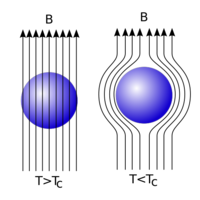Meissner effect: Difference between revisions
Ooshinowo3 (talk | contribs) |
Ooshinowo3 (talk | contribs) |
||
| Line 43: | Line 43: | ||
http://www.imagesco.com/articles/superconductors/superconductor-meissner-efsfect.html | http://www.imagesco.com/articles/superconductors/superconductor-meissner-efsfect.html | ||
See link | See link to the right to read more on superconductors. | ||
[[http://www.physicsbook.gatech.edu/Superconductors]] | [[http://www.physicsbook.gatech.edu/Superconductors]] | ||
Revision as of 13:53, 5 December 2015
claimed by ooshinowo3
What is the Meissner Effect
The Meissner effect is the expulsion of a magnetic field from a superconductor during its transition to the superconducting state, discovered by German physicists Walther Meissner and Robert Ochsenfeld in 1933. They discovered it by measuring the magnetic field outside superconducting tin and lead.

What is diamagnetism?
Some materials tend to expel a magnetic field, materials that do this are called diamagnetic, but the effects of this diamagnetism are weak. For example, water and the human body are diamagnetic materials. Diamagnetism is a weak repulsion from a magnetic field. It is a form of magnetism that is only exhibited by a substance in the presence of an externally applied magnetic field. It results from changes in the orbital motion of electrons. Applying a magnetic field creates a magnetic force on a moving electron in the form of F = Qv × B. This force changes the centripetal force on the electron, causing it to either speed up or slow down in its orbital motion. This changed electron speed modifies the magnetic moment of the orbital in a direction opposing the external field.
In superconducting material the Meissner effect creates currents which completely oppose the magnetic field applied by a magnet, in other words they will repel a magnet causing it to levitate. This consequently makes a superconductor in the Meissner state a perfect diamagnet.
How does it Work?
A super conductor with little or no magnetic field within it is said to be in the Meissner state and breaks down when the magnetic field is too large
A superconductor is fundamentally different from a conductor, because Faraday’s law of induction alone does not explain magnetic repulsion by a superconductor. At a temperature below its Critical Temperature, Tc, a superconductor will not allow any magnetic field to freely enter it. This is because microscopic magnetic dipoles are induced in the superconductor that oppose the applied field. This induced field then repels the source of the applied field, and will consequently repel the magnet associated with that field.

This implies that if a magnet was placed on top of the superconductor when the superconductor was above its Critical Temperature, and then it was cooled down to below Tc, the superconductor would then exclude the magnetic field of the magnet. This means that a magnet already levitating above a superconductor does not demonstrate the Meissner effect, while a magnet that is initially stationary and then repelled by a superconductor as it is cooled through its critical temperature does.
What did it lead to?
The theory of the Meissner effect led to the phenomenological theory of superconductivity by Frits London and Heinz London in 1935. This theory explained resistance less transport and the Meissner effect, and allowed the first theoretical predictions for superconductivity to be made as seen below.
By using the London equations and Maxwell equations, one can predict how the magnetic field and surface current vary with distance from the surface of a superconductor.
See also
Superconductors and magnetic flux
Further reading
Albert Einstein (1922). "Theoretical remark on the superconductivity of metals". arXiv:physics/0510251v2. Bibcode:2005physics..10251E. Fritz Wolfgang London (1950). "Macroscopic Theory of Superconductivity". Superfluids. Structure of matter series 1. OCLC 257588418.. Revised 2nd edition, Dover (1960) ISBN 978-0-486-60044-4. By the man who explained the Meissner effect. pp. 34–37 gives a technical discussion of the Meissner effect for a superconducting sphere.
External links
https://www.youtube.com/watch?v=44mVZdnR6Yc https://www.youtube.com/watch?v=bnyB-PInFA4
References
http://hyperphysics.phy-astr.gsu.edu/hbase/solids/meis.html http://www.supraconductivite.fr/en/index.php?p=supra-levitation-meissner-more http://lrrpublic.cli.det.nsw.edu.au/lrrSecure/Sites/Web/physics_explorer/physics/lo/superc_12/superc_12_02.htm http://www.chm.bris.ac.uk/webprojects2006/Truscott/paged_r.html http://www.imagesco.com/articles/superconductors/superconductor-meissner-efsfect.html
See link to the right to read more on superconductors. [[1]]